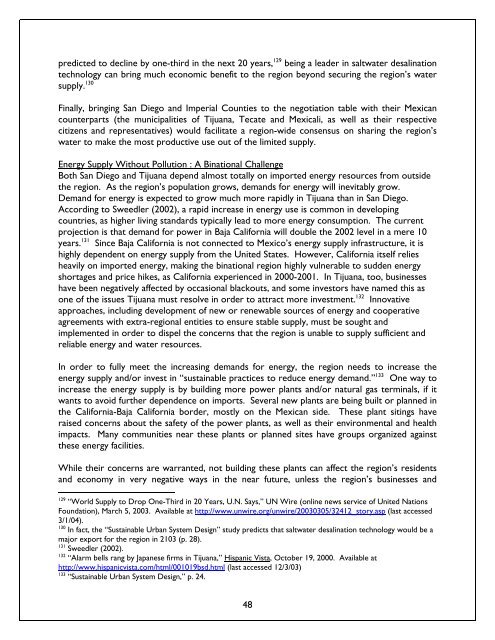Blurred Borders - International Community Foundation
Blurred Borders - International Community Foundation
Blurred Borders - International Community Foundation
Create successful ePaper yourself
Turn your PDF publications into a flip-book with our unique Google optimized e-Paper software.
predicted to decline by one-third in the next 20 years, 129 being a leader in saltwater desalination<br />
technology can bring much economic benefit to the region beyond securing the region’s water<br />
supply. 130<br />
Finally, bringing San Diego and Imperial Counties to the negotiation table with their Mexican<br />
counterparts (the municipalities of Tijuana, Tecate and Mexicali, as well as their respective<br />
citizens and representatives) would facilitate a region-wide consensus on sharing the region’s<br />
water to make the most productive use out of the limited supply.<br />
Energy Supply Without Pollution : A Binational Challenge<br />
Both San Diego and Tijuana depend almost totally on imported energy resources from outside<br />
the region. As the region’s population grows, demands for energy will inevitably grow.<br />
Demand for energy is expected to grow much more rapidly in Tijuana than in San Diego.<br />
According to Sweedler (2002), a rapid increase in energy use is common in developing<br />
countries, as higher living standards typically lead to more energy consumption. The current<br />
projection is that demand for power in Baja California will double the 2002 level in a mere 10<br />
years. 131 Since Baja California is not connected to Mexico’s energy supply infrastructure, it is<br />
highly dependent on energy supply from the United States. However, California itself relies<br />
heavily on imported energy, making the binational region highly vulnerable to sudden energy<br />
shortages and price hikes, as California experienced in 2000-2001. In Tijuana, too, businesses<br />
have been negatively affected by occasional blackouts, and some investors have named this as<br />
one of the issues Tijuana must resolve in order to attract more investment. 132 Innovative<br />
approaches, including development of new or renewable sources of energy and cooperative<br />
agreements with extra-regional entities to ensure stable supply, must be sought and<br />
implemented in order to dispel the concerns that the region is unable to supply sufficient and<br />
reliable energy and water resources.<br />
In order to fully meet the increasing demands for energy, the region needs to increase the<br />
energy supply and/or invest in “sustainable practices to reduce energy demand.” 133 One way to<br />
increase the energy supply is by building more power plants and/or natural gas terminals, if it<br />
wants to avoid further dependence on imports. Several new plants are being built or planned in<br />
the California-Baja California border, mostly on the Mexican side. These plant sitings have<br />
raised concerns about the safety of the power plants, as well as their environmental and health<br />
impacts. Many communities near these plants or planned sites have groups organized against<br />
these energy facilities.<br />
While their concerns are warranted, not building these plants can affect the region’s residents<br />
and economy in very negative ways in the near future, unless the region’s businesses and<br />
129<br />
“World Supply to Drop One-Third in 20 Years, U.N. Says,” UN Wire (online news service of United Nations<br />
<strong>Foundation</strong>), March 5, 2003. Available at http://www.unwire.org/unwire/20030305/32412_story.asp (last accessed<br />
3/1/04).<br />
130<br />
In fact, the “Sustainable Urban System Design” study predicts that saltwater desalination technology would be a<br />
major export for the region in 2103 (p. 28).<br />
131<br />
Sweedler (2002).<br />
132<br />
“Alarm bells rang by Japanese firms in Tijuana,” Hispanic Vista, October 19, 2000. Available at<br />
http://www.hispanicvista.com/html/001019bsd.html (last accessed 12/3/03)<br />
133<br />
“Sustainable Urban System Design,” p. 24.<br />
48















